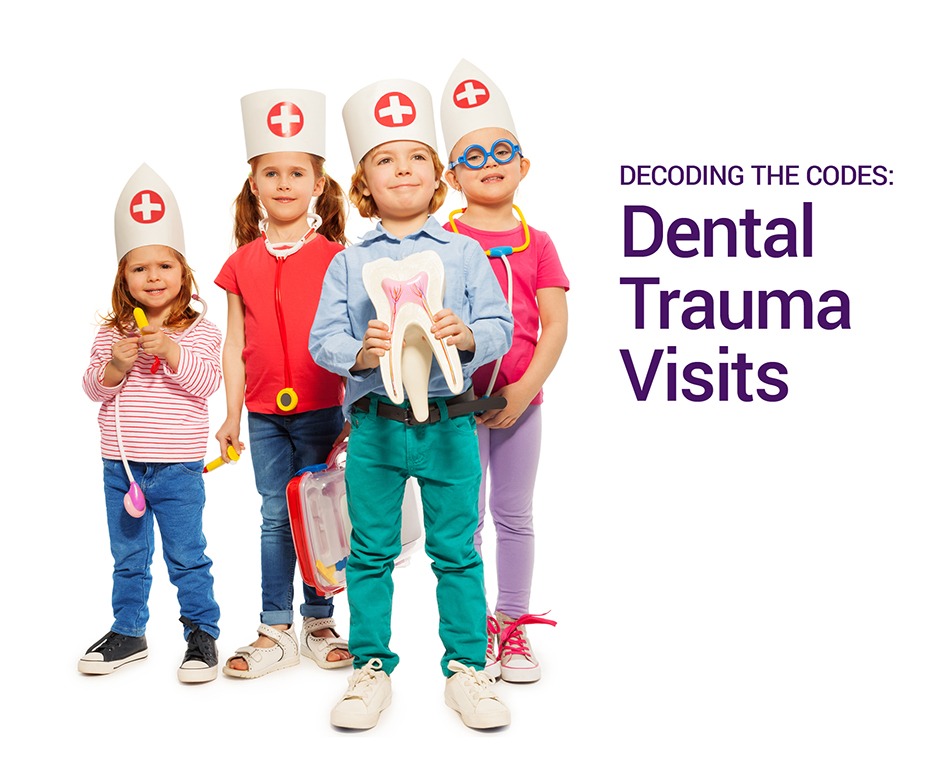Pediatric dentists often see children for traumatic dental injuries as a result of an accident or sports injury. Minor injuries are most common and may include concussion and subluxation and/or minor fractures. More severe injuries are less common and may include lateral or extrusive luxation and partial or full avulsion. Treatment of dental trauma can vary greatly depending on the type and severity of the injury. It can be challenging to know the proper dental codes to use for each situation.
Regardless of the severity of the injury, when seeing a patient for dental trauma, it is important to use the correct exam code. As you are only examining the tooth or teeth, or area of the mouth affected, you are performing a limited, problem-focused examination. Even if you are seeing a patient for the first time, if it is for an emergency, you should charge the limited problem-focused oral evaluation code D0140. The ADA code D0150 should only be used If you convert the patient to a true new patient and perform a comprehensive full mouth examination.
When a patient presents with a minor dental injury and the examination and x-ray reveal a small chip or fracture where only the enamel is involved, and you smooth rough edges, one of two ADA codes could be used. Please be aware the codes described below (D9110 and D9971) cannot be billed on the same date of service.
D9110 – Palliative treatment of dental pain – minor procedure
D9110 is for palliative care (minor procedures) on emergency visits. D9110 should be used when performing non-definitive procedures and can only be billed out with x-rays on the same date of service. You cannot use D9110 in conjunction with another exam code or definitive procedures such as a filling or extraction. Please note if submitting to dental insurance, most require a narrative in order to be considered for reimbursement.
The other ADA code that could be used in this scenario is:
D9971 – Odontoplasty 1–2 teeth – includes removal of enamel projections.
Odontoplasty (D9971) code can be used in combination with a limited oral evaluation and x-rays. This code can be used for up to 2 teeth and may only be charged again if more than 2 teeth require this treatment. This code is often used for minor cosmetic corrections and may not be covered by some dental plans. If you are using this code in conjunction with the treatment of a dental injury, it is wise to include a narrative with your dental claim for it to be considered for payment.
If the chip or fracture is more extensive or into the pulp of the tooth, you should proceed with the appropriate treatment such as a pulpotomy and filling or crown.
More severe tooth injuries where a tooth has been displaced may require gentle repositioning of the tooth or reimplantation. Reimplantation should be used for permanent teeth only. For this type of injury, splinting may also be used to stabilize the tooth to ensure the tooth heals in the correct position. As this type of injury is less commonly seen, it may be difficult to know or remember the proper ADA code to charge. Many times, when searching for the proper ADA code to use in this situation, incorrect periodontal codes are chosen as stabilization is used in their description. The periodontal codes (D4320 and D4321) should only be used for teeth that are mobile due to periodontal disease and will be denied if used for dental trauma. The correct ADA code can be found in the oral and maxillofacial surgery section (D7270).
D7270 – Tooth reimplantations and/or stabilization of accidentally avulsed or displaced tooth.
Please note this code includes splinting, stabilization, and/or reimplantation and requires a tooth designation.
As with any dental services you provide, it is recommended to verify the procedures with the patient’s dental insurance. Some insurance companies may not consider one or more of these codes as a covered benefit or apply frequency limitations. It is recommended, even in urgent dental cases, to inform the patient’s parents before performing any dental treatment what their estimated financial responsibility will be.
*Disclaimer: This information is to be used as a guide and is in no way legal advice. For questions on insurance billing, please contact the insurance company directly.

Lilly Cortes-Pona is the owner and president of LCP Dental Team Coaching, a nationally recognized coaching firm specializing in pediatric dentistry since 1996.
FMI: 303-660-4390 or Info@LCPCoaching.com
Read more from Lilly:

